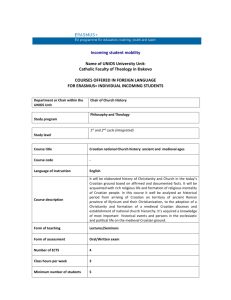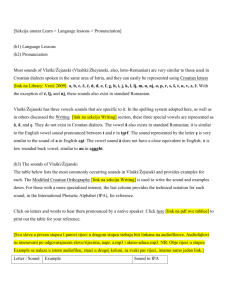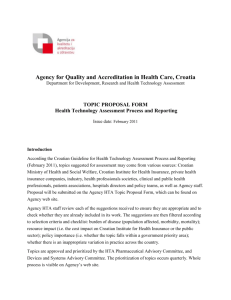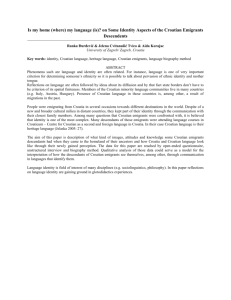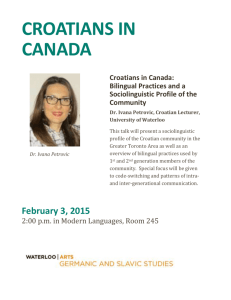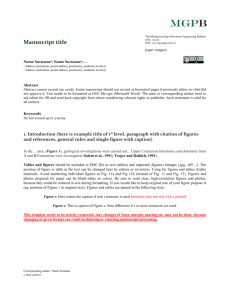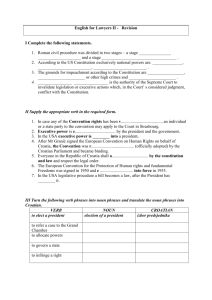Višnja Josipović Smojver
advertisement
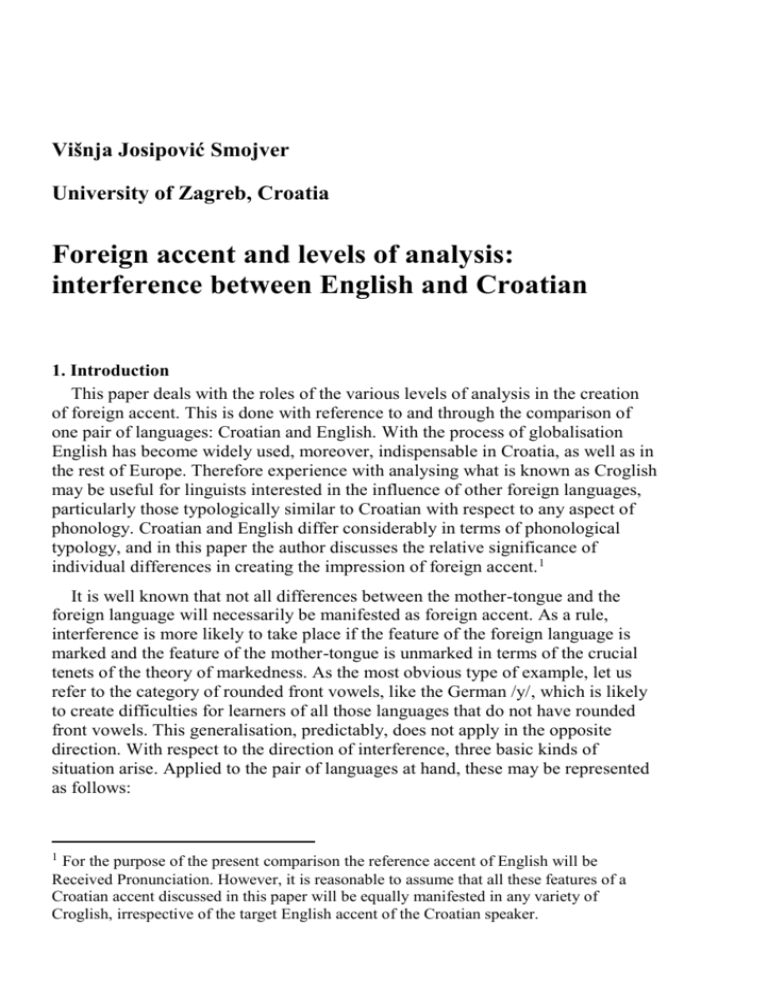
Višnja Josipović Smojver University of Zagreb, Croatia Foreign accent and levels of analysis: interference between English and Croatian 1. Introduction This paper deals with the roles of the various levels of analysis in the creation of foreign accent. This is done with reference to and through the comparison of one pair of languages: Croatian and English. With the process of globalisation English has become widely used, moreover, indispensable in Croatia, as well as in the rest of Europe. Therefore experience with analysing what is known as Croglish may be useful for linguists interested in the influence of other foreign languages, particularly those typologically similar to Croatian with respect to any aspect of phonology. Croatian and English differ considerably in terms of phonological typology, and in this paper the author discusses the relative significance of individual differences in creating the impression of foreign accent. 1 It is well known that not all differences between the mother-tongue and the foreign language will necessarily be manifested as foreign accent. As a rule, interference is more likely to take place if the feature of the foreign language is marked and the feature of the mother-tongue is unmarked in terms of the crucial tenets of the theory of markedness. As the most obvious type of example, let us refer to the category of rounded front vowels, like the German /y/, which is likely to create difficulties for learners of all those languages that do not have rounded front vowels. This generalisation, predictably, does not apply in the opposite direction. With respect to the direction of interference, three basic kinds of situation arise. Applied to the pair of languages at hand, these may be represented as follows: 1 For the purpose of the present comparison the reference accent of English will be Received Pronunciation. However, it is reasonable to assume that all these features of a Croatian accent discussed in this paper will be equally manifested in any variety of Croglish, irrespective of the target English accent of the Croatian speaker. Višnja Josipović Smojver Croatian English English Croatian Croatian English The first type of interference may be illustrated by the situation when a Croatian speaker pronounces the English adjective "red" as [red], using the Croatian trill as the initial consonant, rather than the appropriate frictionless continuant of the target English accent. In view of what the theory of markedness predicts, in this particular case, the trilled articulation is more likely to be carried over to English at lower levels of competence. Such cases of "beginners' pronunciation", however, are not as interesting in the study of interference as those typically occurring in fluent non-native English, as these latter in fact give identity to Croglish as opposed to other foreign accents. The second type of interference identified above can be illustrated by the opposite example. When native English speakers learn Croatian, they are likely to replace the Croatian trill or flap by the English frictionless continuant occurring in words like "red". As predicted by the theory of markedness, this tends to be a general feature of Croatian spoken with an English accent. However, such cases are not the focus of attention here, as they do not characterize Croglish, but rather, Croatian spoken with an English accent. By contrast, cases illustrating the third situation, viz. interference commonly taking place in both directions, will be discussed in detail, as they mostly and most obviously involve features that characterize fluent Croglish, particularly its prosody. Notably, these turn out to be the most elusive and hence the most challenging in dealing with the present topic. In short, although it may often be instructive to point to any differences between the two languages concerned, irrespective of the predictable direction of interference, this paper focuses primarily on those differences which go in the direction of English, particularly those characterising fluent Croglish. In other words, the main concern here is the identification of those features of pronunciation which are likely to create the impression of a specific Croatian accent in English. The phonological and phonetic differences between the two languages under consideration will be looked at on two basic levels of analysis: segmental and suprasegmental. At the segmental level, consonantal and vocalic systems will be looked at separately. With respect to prosody, three types of differences will be discussed: those resulting from the typological differences between the two 2 Foreign Accent and Levels of Analysys systems; differences concerning vowel reduction, and, finally, intonational differences. 2. Segmental differences between Croatian and English 2.1. Consonants Within the consonantal systems, two kinds of differences can be noticed between the two languages under consideration: differences in the phonemic inventories and phonetic differences. The former concern the pronunciation of those English sounds which Croatian does not use distinctively, notably /Ɵ, ð, and w/. Typically, at least at lower levels of competence, in Croglish these are substituted by their most similar Croatian correlates, /t/, /d/ and /v/. Among pronunciation features of Croglish, a special place is occupied by two features which on the face of it look like manifestation of mere phonetic interference, but in fact result from the differences in the phonemic inventories between the two languages. In its consonantal system Croatian has two distinctive palatals, which as such do not occur in English, namely the lateral /ʎ/ and the nasal /ɲ/. Even in the speech of the most fluent Croglish speakers these are commonly heard as realizations of the English sequences /l+j/, as in "value" and /n+j/ as in "news", as a result of the misinterpretation of these sequences in terms of native phonological categories. As for the phonetic transfer of native features, cases in point include, above all, the approximant realisation of the English phoneme /v/, as in "very", which even in the most fluent variants of Croglish turns out to be ʋeɹi and which was proved by empirical research to be rated by native judges as the most prominent consonantal give-away of a Croatian accent.2 This category also comprises the cases of mispronunciation of the English phoneme /r/ referred to above. If manifested in this way in Croglish, /r/ tends to be realised by a flap or a trill sound. Phonetic interference is likewise commonly heard in the realisation of the voiceless stops, /t/, /p/, k/, which Croatian speakers typically fail to aspirate in the appropriate contexts. /t/ is additionally interesting in this context, because its place of articulation is slightly different in Croatian than it is in English, the typical representative of the category being dental, rather than alveolar. The pronunciation For details of the experimental research see Josipović (1987) and Josipović & Šikić (1989). 2 3 Višnja Josipović Smojver of voiced obstruents also deserves some attention in the present context, in that experimental studies on give-away features of Croglish show that Croatian speakers of English devoice final obstruents to a greater extent than expected in any standard variety of English pronunciation. However, it should be noted that this is not at all interference of Croatian, as the subjects involved in this research did not have a Final Devoicing Rule comparable to that of German in their native dialect of Croatian.3 Rather, it should be interpreted as a general feature of foreign accent, commonly referred to within the framework of Optimality Theory as a well-known phenomenon characterizing second language phonology in general. Thus with reference to Mandarin Chinese interference in English pronunciation, Kager, Pater and Zonneveld (2004: 25) interpret such cases as the hierarchical superiority of the markedness constraint *VOICED CODA to the faithfulness constraint IDENT- IO(voice) in second/foreign language phonology. Three more subtle phonetic differences between Croatian and English are likely to be manifested in Croglish and noticed by most native English judges. The first one is the failure to realize the English /l/ by its velarised ("dark") allophone in the syllable coda and hence the clearness of the /l/ in all positions. Another one is the phonetic quality of the Croatian affricates, which are correlates of the English consonants /tʃ/ and /dʒ/. The situation concerning the affricates in Croatian is somewhat more complex than in English, in that Croatian has two pairs of consonants belonging to this category, the "hard" ones, /tʃ/ and /dʒ/ and the soft ones, /tɕ, ʥ/. Although the functional burden of the distinction between the "hard" and the "soft" ones is very low and the contrast has actually been lost from the speech of many speakers of Croatian, these affricates regularly cause interference. Irrespective of whether a given native speaker of Croatian preserves the contrast in his native dialect and how "hard" or "soft" the preserved affricates are, their respective phonetic qualities regularly sound slightly strange to a native English ear. For the "soft" ones this difference is reflected by the corresponding IPA symbols for their second element, which both indicate a prepalatal release. The "hard" ones, although being represented by the same IPA symbols as their English correlates, also differ from them in the point of release, which is typically alveolar in Croatian, rather than being palato-alveolar, as in English. Thus in any case, no matter what the phonetic quality of a given affricate in Croatian is, it is likely to be different from the one which is expected in native English and as such is likely to contribute to the overall impression of a foreign accent. 3 Although in some dialects of Croatian, word-final obstruents are fully devoiced, the speakers involved in the accent-judging research which is referred to in this paper were all speakers of what is known as 'Implicit Croatian Pronunciation Standard', as defined by Škarić (2006). 4 Foreign Accent and Levels of Analysys Finally, the third subtle phonetic detail noticeable in Croglish is the velar place of articulation of the consonant /h/, as in "heavy", which is typically pronounced as [xeʋi], thus sounding different from the target glottal consonant /h/ heard in any standard varieties of English taught in Croatia. It is important to note that Croatian learners of English are not normally aware of this slight phonetic difference, because they are naturally mislead by the spelling. In both languages this sound is indicated by the same letter, "h", so there is no reason why a Croatian learner of English at any stage would notice this difference and consciously correct their pronunciation to this effect. Even university students of English whose native language is Croatian and who may become teachers of English after graduation, must be taught this explicitly in their phonetics and phonology classes. Moreover, their awareness of the fact is no guarantee of their correct pronunciation of this segment in the future, as by the time one reaches university, the velar pronunciation of /h/ will have become fossilized. As a rule, it takes a considerable degree of effort to "unlearn" it, which lots of speakers of Croglish, unless they are very ambitious and perfectionist about their pronunciation, would not find worth bothering. 2.2. Vowels Within the vocalic system, English has two subsystems: the monophthongs and the dyphthongs, whereas Croatian does not have dyphthongs in the real sense of the term. This already makes the English vocalic system more complex than the Croatian one. However, this difference does not represent a major source of interference. What matters much more in this respect are the striking differences in the systems of monophthongs, which can hardly fail to result in foreign accent give-aways. First of all, it should be noted that the RP system of monophthongs, commonly described as quadrangular (even-numbered), includes twelve distinctive vowels.4 By contrast, the Croatian vocalic system, which is a triangular (odd-numbered) one, has only five vowels. Most notably, each of the items from the English set, including /i:, ɪ, e, æ, ɜ:, ǝ, ʌ, ɑ:, ɒ, ɔ:, ʊ, and u:/ has a considerably different phonetic quality from its correlate from the Croatian set (a, e, i, o, u). This applies even to /e/, which is represented by the same IPA symbol in the two languages, but exhibits notable phonetic differences in the two languages. Comparing the data provided by Gimson (1980) for English and by Bakran (1996) for Croatian, the mean formant differences in Hz between the Croatian and English /e/, are given in the following table: 4 Admittedly, the exact number of items in any phonological system always depends on the analysis, but the description of the phonemic system of RP in this paper is based on the well-established and widely accepted Gimson's analysis, as presented in Cruttenden (2008). 5 Višnja Josipović Smojver F1 F2 F3 Croatian /e/ 471 1,848 2,456 English /e/ 600 2,060 2,840 Table 1: The mean frequencies of the first three formants for /e/ in Croatian and English Before proceeding with the comparison of other Croatian vowels and their English counterparts in terms of the basic acoustic parameters, a brief comment on the data in Table 1 is in order. Being inversely related to vowel height, the location of the first formant is in principle a diagnostic for vowel openness. Thus the English /e/ with its F1 value of 471 Hz should be more open than the Croatian /e/, whose F1 value is 471 Hz. As for the other formant values included in Table 1, it is interesting to comment upon the distance between F1 and F2, as this is indicative of the vocalic quality along the dimension front – back. In particular, for the Croatian /e/ the difference between F2 and F1 is 1,377 Hz, and for its English correlate it is 1,460 Hz. The more far apart the first two formants are, the more front a vowel is. This suggests that the English /e/ should be somewhat more front, or more peripheral than its Croatian correlate. In this case the two vowels under consideration are obviously phonetically different, even though they are covered by the same IPA symbol, as well as often being indicated by the same letter in the spelling, as is regularly the case with the consonant /h/ discussed above. Of course, one should always be aware of the fact that such acoustic data for individual segments necessarily involve quite a degree of abstraction, as individual segments are not normally pronounced in isolation in natural speech and their actual phonetic quality will always depend on the surrounding context and the effects of coarticulation. However, this kind of comparison does provide some useful insights into the nature of mother-tongue interference on the segmental level, as the differences of this type are regularly noticed as give-aways of a given accent (native or non-native) in pronunciation judgement experiments (cf. Cunningham 2008, van den Doel 2008). As for the degree of rounding, which is normally also one of the crucial parameters in defining vocalic quality, the situation is somewhat more complicated than it is for the degree of opening and the quality along the front-back parameter. Although in principle the degree of rounding of a vowel is reflected on the spectrogram by the frequencies of the higher formants, which tend to decrease with the increase of rounding, there are no general definitions of this correlation. For the pair of vowels at hand, however, this does not seem to be relevant anyway, as they are both notably unrounded. 6 Foreign Accent and Levels of Analysys For the remaining comparable correlates of Croatian and English vowels analogous data for the first three formants will be provided in Table 2 and Table 3, respectively. As among these vowels there are no such obvious correlates, indicated by the same IPA symbols, as was the case with /e/, the phonetic differences among similar items in the two languages will be additionally indicated by their respective symbols and are expected to be even more notable than in the case of Croatian /e/ vs. English /e/. English vowel F1 F2 F3 /i:/ 280 2,620 3,380 /ɪ/ 360 2,220 2,960 /e/ 600 2,060 2,840 /æ/ 800 1.760 2,500 /ʌ/ 760 1,320 2,500 /ɑ:/ 740 1,180 2,640 /ɒ/ 560 920 2,560 /ɔ:/ 480 760 2,620 /ʊ/ 380 940 2,300 /u:/ 320 920 2,200 /ɜ:/ 560 1,480 2,520 Table 2: The mean frequencies (in Hz) of the first three formants for RP pure vowels (Gimson 1980) As can be seen from Table 3, giving the analogous formant values for the five distinctive standard Croatian values, even in cases where phonetic symbols suggest similar vowel types, the individual formant values for any pair of vowels are again notably different: 7 Višnja Josipović Smojver Croatian vowel F1 F2 F3 /i/ 282 2,192 2,713 /e/ 471 1,848 2,456 /a/ 664 1,183 2,433 /o/ 482 850 2,472 /u/ 324 717 2,544 Table 3: The mean frequencies for Standard Croatian vowels (Bakran 1996) Once again, it should be stressed that this kind of comparison necessarily involves a great deal of abstraction, not only because of coarticulation in natural speech, mentioned in connection with the pronunciation of consonants, but also because of the role played by dialectal variation in vocalic quality. This kind of variation is quite easily detectable in the speech of real Croglish speakers, as not every speaker of Croglish is necessarily a speaker of the Croatian pronunciation standard. Another important point to make about the differences between the two vocalic systems concerns vocalic length. In English vocalic length in itself is not an inherent phonological feature of vowels. As will be explained in more detail shortly, in combination with tone, vocalic length in Croatian can give identity to lexical prosodic patterns. This means that vocalic length functions as a phonological parameter independent of vocalic quality. Thus with the same vocalic quality of the vowel , the word "pas" will mean "belt" in Croatian if it is long, and in case it is short, it means "dog". For the time being, we can abstract away from the way tone combines with vocalic length and leave this for the next heading, as this does not make any difference to the phonological role of vocalic length. In any case, then the phonological role of vocalic length is different in English and the actual phonetic duration of a vowel depends largely upon the voicing of the following consonant. Any English vowel will be made shorter before a voiceless consonants by a rule known as Pre-Fortis Clipping. The speakers of languages like Croatian, where there is no comparable rule, will naturally fail to apply it to English, believing that the tense vowels are automatically long and the lax ones are short, irrespective of the context in which they occur. This illusion is reinforced by their corresponding IPA symbols, which, admittedly, not without phonological justification, associate length with tenseness. 8 Foreign Accent and Levels of Analysys Unless they have had formal phonetics training at university, Croatian learners of English are unlikely to be aware of the qualitative differences entailed by the differences like, for example, "ordinary" /i/ or /u/ vs. /ɪ/ or /ʊ/, respectively. Likewise, all vocalic qualities represented by any a-like symbols are likely to be perceived and realized by them as a fully front and open vowel /a/, which they have in their native vocalic system. For those learners whose attention has been drawn to such subtleties of pronunciation, just like in the case of /e/, referred to above, it may be too late to correct their English pronunciation in the direction of more native-like vowels. It should be noted that there is an item in the vocalic system of English, which is missing from the above tables, because of its special phonological status,5 but is generally associated with non-native pronunciation of English. This is the schwa, /ǝ/, occurring in unstressed syllables in the standard varieties of native English pronunciation. The common failure on the part of non-native speakers of English, including the Croatian ones, to reduce unstressed vowels to schwa regularly results in the mispronunciation of this statistically most frequent vowel of English. This, however, will be dealt with in more detail in 3.2., in connection with the prosodic aspects of Croglish. In short, taking into consideration all that has been said about the differences between the two vocalic systems, it may be observed that they are indeed striking and as such must contribute considerably to the creation of the impression of nonnativeness of Croglish. 3. Suprasegmental differences 3.1. Rhythm Croatian and English are also notably different in terms of rhythm. In rhythmic typology English rhythm is commonly referred to as an example of an extreme case of stress-based rhythm. Croatian rhythm, by contrast, is closer to the opposite type, syllable-based rhythm. The position of any given language on this imaginary scale ranging from extreme stress-based rhythm to extreme syllable-based rhythm is determined by the extent to which the rhythmic features of the one or the other 5 Although its phonetic quality distinguishes it from the other items in the vocalic system, in contemporary phonology it is not commonly treated as a separate phoneme of English, but rather, an empty slot on the timing tier filled up by the most unmarked segment, mere phonation without articulation, phonetically realized as [ǝ] (cf. Szpyra 1995) 9 Višnja Josipović Smojver type are present.6 Therefore, in the present context it is important to note the five differences between Croatian and English rhythm, established and discussed in more detail in Josipović (1994) and summed up in the following table: 1 2 3 Syllable-based rhythm (Croatian) Proportional reduction of all syllables with the increase of interstress material Stress-based rhythm (English) Greater reduction of unstressed syllables with the increase of interstress material Smaller quantitative differences among unstressed syllables Smaller extent of final lengthening Greater quantitative differences among unstressed syllables Greater extent of final lengthening Preference for regressive Preference of anticipatory compression of stressed vowels in a compression of unstressed vowels in stress group a stressed group Increase of speech rate achieved at 5 Increase of speech rate achieved at the expense of consonants the expense of vowels Table 4: Syllable-based rhythm (Cr.) vs. stress-based rhythm (E) 4 Even at a first glance it is clear that the rhythmic distortions resulting from the differences between Croatian and English referred to in Table 4 must be striking to a native English ear. However, two other aspects of a Croglish accent that are inseparably related to these rhythmic differences predictably bring about further, even more striking distortions of the target English prosody. These concern the Vowel Reduction Rule and the wrong location of intonational peaks, which will be looked at in turn. 3.2. Vowel reduction The syllable-based nature of English rhythm is inseparable from another prosodic phenomenon associated with English pronunciation, the reduction of unstressed vowels. The most important point to note about this reduction is that it is not just mere shortening of unstressed vowels, but primarily a process of qualitative reduction. Moreover, as argued as far back as in 1983 by Dauer, the difference between stress-based and syllable-based rhythm is not at all based on the temporal organization of speech, but, rather on the perceptual illusion of isochrony of inter-stress stretches in languages like English, created by the 6 For a detailed discussion of the criteria involved in this typology see Dauer (1983) and Fant, Kruckenberg and Nord (1991). 10 Foreign Accent and Levels of Analysys "conspiracy" between stress and syllable structure. 7 Thus the qualitative reduction of vowels in English together with all the other features of stress-based rhythm referred to in Table 4 significantly determines the prosodic nature of English. Non-native speakers who fail to apply this rule, like speakers of Croglish, are then bound to sound as foreigners to a native English ear, even if in some hypothetical situation they pronounced everything else correctly. However, in natural situations, as a result of coarticulation, qualitative distortions of individual vowels will necessarily entail the mispronunciation of the surrounding segments to a smaller or greater degree. 3.3. Tonal aspects of Croglish It is also in terms of tonal typology that Croatian and English belong to two totally different types of languages. Whereas Croatian is a mora-based pitchaccent language, using tones associated with individual moras to give words their lexical identity, English is an intonation language. That is, English uses tonal patterns exclusively for intonational purposes. What actually gives Croatian its prosodic identity is primarily the interaction of the lexical prosodic patterns with intonational patterns. This interaction is so notable in the speech of Croatian speakers, that by the prosody of a speaker's Croglish it is often possible to tell which part of Croatia they come from. For example, by the way they pronounce English polysyllabic words like "curiosity" or "university", one can usually distinguish a speaker coming from Split from someone coming from Osijek. In this particular case, the former is likely to have a tonal distance between the accented and the post-accentual syllable corresponding to that of the musical fourth. By contrast, in the speech of the person from Osijek the interval will probably be that of the musical second. A wealth of interesting data on the regional variation in Croatian lexical prosody is given in Pletikos (2008). However, this precious piece of research on Croatian prosody is basically not a contrastive one, so it does not make any explicit statements about the way in which these features are transferred to the pronunciation of a foreign language. More detailed accounts of the tonal features of Croglish are given in Josipović (1995 and 1998). The most recent study of Neo-Štokavian intonation within the same kind of bitonal generative compositional model (known as the Pierrehumbert model), with undisputable implications on Croatian prosody is given in Godjevac (2005). Although like Pletikos, Godjevac does not deal with features of Croglish, these implications suggest that the features described as characterizing Croglish 7 The realization of the illusory nature of isochrony has led phoneticians to abandon the earlier terms "stress- vs. syllable-timed" in favour of the presently used terms "stress- vs. syllable-based" languages. The term "conspiracy" used in this sense, reportedly, had originally been introduced by Ladefoged . 11 Višnja Josipović Smojver prosody by Josipović (1995 and 1997), still naturally follow from all the prosodic differences described above. They may be summed up as follows: in the first place, as a result of the characteristic rhythmic distortions, one may expect the wrong timing of crucial melodic peaks. Secondly, being speakers of a language using vocalic length, Croats are unlikely to resort to processes of metric or emphatic lengthening characteristic of English, since in their native language they cannot afford to affect the inherent vocalic length, because it gives lexical identity to words. In addition, no matter which model of phonological analysis of intonation one subscribes to, there is always the likelihood of the wrong use of individual intonational morphemes. The narrower repertoire of the latter in Croatian, recognized by all approaches and relatable to the constraints arising from the pitch-accent nature of Croatian prosody, results in resorting to un-English means of expressing the pragmatic purposes of the items missing in Croatian. Notably, these include a wide range of alternative, paralinguistic means of expression, such as voice quality, facial expression and gestures, as well as pragmatic particles. 4. Conclusion By way of conclusion, it may be observed that at each of the levels of analysis discussed above there are striking phonological and phonetic differences between Croatian and English. Although it is possible to point to each of them as a potential source of some feature of English pronounced with a Croatian accent, in real speech they often co-occur and interact with each other, which always makes the phenomenon of a foreign accent so complex and challenging. In any case, pointing to them can lead to precious insights into the nature of both languages involved and the nature of foreign accent in general. In teaching English as a foreign language such insights can be useful in attenuating the foreign accent and thus improving English pronunciation. References Bakran, J. (1996). Zvučna slika hrvatskoga govora. Zagreb: IBIS grafika. Cruttenden, A. (2008). Gimson's Pronunciation of English. 7th edn. London: Hodder Arnold. Cunningham, U. (2008). "Quality, quantity and intelligibility of vowels in Vietnamese-accented English", paper presented at the International conference of native and non-native accents of English. Łódź, 12-14 December 2008. 12 Foreign Accent and Levels of Analysys Dauer, R.M. (1983). "Stress-timing and syllable-timing reanalysed." J. Phonetics 11. pp.51-62. Fant, G., A. Kruckenberg and L. Nord (1991). "Temporal organization and rhythm in Swedish." Aix-en-Provence: ICPhS, Vol. I. pp. 247-250. Gimson, A.C. (1980). An Introduction to the Pronunciation of English. London: Arnold. Godjevac, S. (2005). "Transcribing Serbo-Croatian Intonation". In: Sun-Ah Jun, ed. Prosodic Typology: The Phonology of Intonation and Phrasing. Oxford: Oxford University Press. pp. 146-171. Josipović, V. (1987). "Interference of Croatian in the Pronunciation of the Twelve Most Frequent RP Consonants". Studia romanica et anglica zagrabiensia. Vol. 31-32, 1986-7. pp.117-128. Josipović, V. and L. Šikić (1989). "Interferencija hrvatskoga jezika u izgovoru engleskog konsonanta /v/". Proceedings of the Croatian Society of Applied Linguistics (HDPL). Zagreb: 1989. pp. 149-154. Josipović, V. (1994). English and Croatian in the Typology of Rhythmic Systems. Studia romanica et anglica zagrabiensia. Vol. 39. pp. 25-37. Josipović, V. (1995). "The Intonational Systems of English and Croatian: A Bitonal generative Compositional Approach". Studia romanica et anglica zagrabiensia. Vol. 40. pp. 191-220. Josipović, V. (1997). "The Prosody of English Spoken with a Croatian Accent". In: Waniek-Klimczak, E., ed. (1997). Teaching English Phonetics and Phonology II. Accents '97. Łódź: Wydawnictwo Universytetu Łódzkiego. pp. 85-93. Kager, R., J. Pater and W. Zonneveld (2004). Constraints in Phonological Acquisition. Cambridge University Press. Pletikos, E. (2008). Akustički opis hrvatske prozodije riječi. Unpublished Ph.D. thesis. University of Zagreb. Szpyra, J. (1995). Three Tiers in Polish and English Phonology. Lublin: Wydawnictwo Universytetu Marii Curie-Skłodowskiej. Škarić, I. (2006). Hrvatski govorili! Zagreb: Školska knjiga. van den Doel, R. (2008), " 'I hear tomayto, you hear tomahto': the different perceptions of non-native speech by British, Irish and North American 13 Višnja Josipović Smojver respondents". Paper presented at the International conference of native and non-native accents of English. Łódź, 12-14 December 2008. 14
